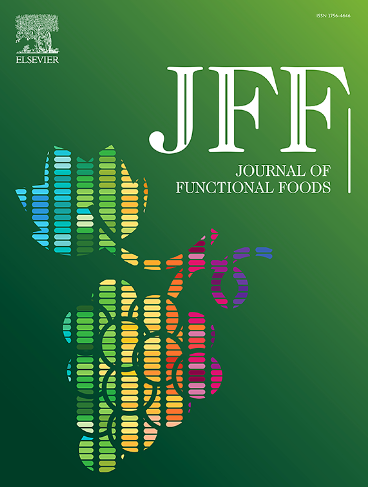EPA-enriched sulfoquinovosyldiacylglycerol attenuates inflammation in lipopolysaccharide-stimulated RAW264.7 macrophages
IF 3.8
2区 农林科学
Q2 FOOD SCIENCE & TECHNOLOGY
引用次数: 0
Abstract
The marine diatom Phaeodactylum tricornutum contains a diverse range of structurally unique bioactive compounds, such as eicosapentaenoic acid-enriched sulfoquinovosyldiacylglycerol (EPA-SQDG). The present study aimed to elucidate the anti-inflammatory role and the underlying mechanisms of EPA-SQDG in lipopolysaccharide (LPS)-stimulated RAW264.7 macrophages. The results demonstrated that EPA-SQDG dose-dependently suppressed LPS-induced overexpression of pro-inflammatory molecules in RAW264.7 macrophages, including NO, iNOS, COX-2, TNF-α, IL-1β, and IL-6. Additionally, EPA-SQDG notably blocked LPS-induced degradation of IκBα and nuclear translocation of NF-κB. Moreover, EPA-SQDG markedly inhibited the phosphorylation of ERK 1/2, JNK, and p38 MAPKs. Furthermore, EPA-SQDG significantly reduced the intracellular ROS generation, and enhanced the nuclear Nrf2 protein levels, and HO-1 expression in LPS-stimulated RAW264.7 macrophages. These findings collectively suggest that EPA-SQDG exerts potent anti-inflammatory effect through coordinated modulation the NF-κB, MAPKs, and Nrf2/HO-1 signaling pathways, highlighting its potential as a functional ingredient for prevention and treatment of inflammatory diseases.

富含epa的磺基喹烷基二酰基甘油减轻脂多糖刺激的RAW264.7巨噬细胞的炎症
海洋硅藻褐藻(Phaeodactylum tricornutum)含有多种结构独特的生物活性化合物,如富含二十碳五烯酸的磺基喹啉二酰基甘油(EPA-SQDG)。本研究旨在阐明EPA-SQDG在脂多糖(LPS)刺激的RAW264.7巨噬细胞中的抗炎作用及其机制。结果表明,EPA-SQDG剂量依赖性地抑制lps诱导的RAW264.7巨噬细胞中促炎分子的过表达,包括NO、iNOS、COX-2、TNF-α、IL-1β和IL-6。此外,EPA-SQDG明显阻断lps诱导的i -κB α降解和NF-κB核易位。此外,EPA-SQDG显著抑制ERK 1/2、JNK和p38 MAPKs的磷酸化。此外,EPA-SQDG在lps刺激的RAW264.7巨噬细胞中显著减少细胞内ROS的产生,提高核Nrf2蛋白水平和HO-1表达。这些发现共同表明,EPA-SQDG通过协调调节NF-κB、MAPKs和Nrf2/HO-1信号通路发挥强大的抗炎作用,突出了其作为预防和治疗炎症性疾病的功能成分的潜力。
本文章由计算机程序翻译,如有差异,请以英文原文为准。
求助全文
约1分钟内获得全文
求助全文
来源期刊

Journal of Functional Foods
FOOD SCIENCE & TECHNOLOGY-
CiteScore
9.60
自引率
1.80%
发文量
428
审稿时长
76 days
期刊介绍:
Journal of Functional Foods continues with the same aims and scope, editorial team, submission system and rigorous peer review. We give authors the possibility to publish their top-quality papers in a well-established leading journal in the food and nutrition fields. The Journal will keep its rigorous criteria to screen high impact research addressing relevant scientific topics and performed by sound methodologies.
The Journal of Functional Foods aims to bring together the results of fundamental and applied research into healthy foods and biologically active food ingredients.
The Journal is centered in the specific area at the boundaries among food technology, nutrition and health welcoming papers having a good interdisciplinary approach. The Journal will cover the fields of plant bioactives; dietary fibre, probiotics; functional lipids; bioactive peptides; vitamins, minerals and botanicals and other dietary supplements. Nutritional and technological aspects related to the development of functional foods and beverages are of core interest to the journal. Experimental works dealing with food digestion, bioavailability of food bioactives and on the mechanisms by which foods and their components are able to modulate physiological parameters connected with disease prevention are of particular interest as well as those dealing with personalized nutrition and nutritional needs in pathological subjects.
 求助内容:
求助内容: 应助结果提醒方式:
应助结果提醒方式:


